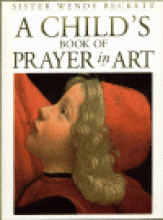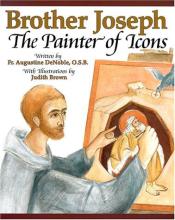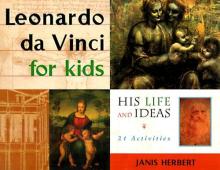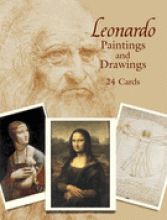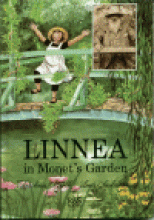Art Appreciation
A Child's Book of Prayer in Art
This book is designed to help your child discover the lessons present in many fine works of art. The inside cover explains "In this, her first book for children, Sister Wendy has selected paintings that can speak to children, illustrating the important values of life, such as love, respect and forgiveness. She helps children to look and listen, gaining insight into art while developing a greater understanding of their own spirituality." For an art book published by a secular company the material is fairly religious and includes such paintings as French Peasant Girls Praying, The Martyrdom of Saint Clement, Christ Discovered in the Temple, The Kiss of Judas, and The Calling of Saint Matthew. The art selections are great - very classic - and the text is very simple. An interesting side point that homeschoolers will enjoy is that there is a painting called The Young Schoolmistress. In her description, Sister Wendy mentions, "Perhaps she is his big sister and he is being taught on his own at home. It is not only in the classroom, or from qualified teachers, that we learn about the world."
Art Fraud Detective: Spot the Difference, Solve the Crime!
This is an exciting and fun art supplement that kids are sure to love (makes a great gift for Christmas or a birthday). There are three main parts to the book. First is an introduction which explains a problem the art museum is having with forgeries. Several gangs of artists have copied original works, but made very slight changes to them. The object of the book is to identify who is responsible for the various forgeries by looking carefully for very specific clues.
The rest of the book is split into two books on top of each other. The upper part is composed of the forgeries - which look like real art until you look very closely (and thus the magnifying glass). A small symbol on the forgery will tell you how many changes the forger made to the original work. By studying the lower book - which is an art catalog with prints of the real paintings, the reader will discover the differences and solve the crime. The catalog includes information about the type of painting; the artist and when he lived; and a brief story about the painting and its subject. There are a total of thirty-four paintings and there is a complete answer key in the back of the book.
What a creative way to get kids interested in art and...fear not! You'll find no twaddle here. I was very pleased to see the practice in attention-to-detail that this book requires and encourages. It's enjoyable enough that my daughter has enjoyed working through it with friends on sleep-overs. There is one picture that jumps out at me as being a little on the shocking side. It's a picture of a very ugly old lady in a very low-cut dress. The book explains that it is a caricature of older women who try to dress younger but really make themselves look ridiculous. I don't really like the picture, but I don't think it really detracts from the book (it also offers the idea of additional purpose in art and an unusual way of making a point).
A magnifying glass on a ribbon is bound in
Art Masterpieces: A Liturgical Collection
We enjoy CHC products a great deal because they fit naturally into our homeschool and family life. This little art appreciation course is no exception.
Arranged around the liturgical year, the package includes ten beautiful 8" x 10" full color, masterpiece reproductions featuring ten different artists (e.g. Michelangelo, Botticelli, Rembrandt, da Vinci) and a 25 page art appreciation guide. The guide provides excellent suggestions for teaching art appreciation in general (those who are familiar with the Charlotte Mason approach will be right at home) as well as specific suggestions for individual masterpiece focusing on content, line, color, pattern, and design. The information gleaned from this guide can easily be applied to other works of art you may already have in your home too.
In addition to the general use section, the guide devotes one page per month to the study of a particular masterpiece. A monthly theme is suggested along with ideas for integrating the study of the particular artwork into family life. Like other CHC products, this package has incorporated Catholic ideals into a program that is enlightening and edifying while remaining something that real families can easily work into their daily school and family life.
When we first received our package I immediately put all of the pictures into a frame, with the June masterpiece on top. I made a pocket on the cardboard backing to hold the booklet and we have weekly discussions about the picture that now hangs in our living room. Occasionally I take the booklet out of the pocket behind the picture and flip to some discussion prompts about line, form, etc. The children enjoy the looking at all the details in the picture while I ask questions and my husband is delighted to have a variety of religious pictures to brighten our room.
Brother Joseph: The Painter of Icons
Tom was an ordinary boy who loved being outdoors and drawing whatever he saw. Although Tom found school distasteful, his teacher, Sister Aquinas, saw artistic talent in him and encouraged him and lent him books on religious art. He discovered that his favorite artist was Fra Angelico. He attended a high school seminary and discovered that he wanted to be a monk. There he becomes Brother Joseph and finds that his artistic talents are put to good use. "He knows that he is busy about the right things, happy that as an artist he is able to give so much joy and peace to others with his icons."
This is a nice story about art, vocation and using one's talents for God and others. My children especially enjoyed the charming verses that run through the monk's head - "My brush will up and downward go, I'll paint like Fra Angelico!"
Leonardo da Vinci for Kids: His Life and Ideas
Leonardo da Vinci has long been considered the paradigm "Renaissance Man". Through this book, he offers children a great example of enthusiastic love of life and learning. Readers will come away with a greater perspective on and respect for many important ideas: the importance and joy of learning, early advancements in science, general concepts of art and how to appreciate it, basic scientific concepts, ideas for using the imagination and memory, concepts in math relating to science, Renaissance life and much more.
I was impressed with the care the author took in relating so many interesting ideas in an accessible and engaging manner. I found difficult concepts handled graciously and respectfully - particularly for the intended age level. For example, the reader will learn that da Vinci's parents were never married and that this had consequences on his career choices. We learn that da Vinci dissected dead bodies at the morgue for the sake of artistic and scientific learning. At one point the Pope prohibits him from continuing this mode of study. Instead of being judgemental about these sorts of issues or dwelling on them inappropriately, they are explained in clear, simple terms as relevant parts of the story, but without any extra nonsense.
This would make an excellent "spine" text for a study of the Renaissance. In addition to the text and side bars, there are 21 activities relating in various ways to da Vinci's life. They span a wide range: baking, drawing, math, science, painting, observing, language and more. The book is best for independent reading in 6th grade and up. It could be read-aloud to younger children. Most of the activities are suitable for any school-age children.
Enthusiastically recommended!
Donated for review by Chicago Review Press
Leonardo Paintings and Drawings: 24 Cards
24 Postcards in perforated book
Most homeschoolers are familiar with the Montessori-style idea of having children learn to enjoy and appreciate great paintings by studying small post-card size reproductions (especially as promoted by Aline Wolf in Mommy It's a Renoir). This is a very nice program, as I understand it, but I've been frustrated with the lack of beautiful painting collections in postcard size. You can find them here and there at museums, but they have been very difficult to purchase on the web or from catalog. Dover Publications is beginning to fill that gap with some beautiful postcard collections, but Leonardo is my favorite so far.
The set includes 13 reproductions of paintings: Madonna with the Carnation (1475), The Virgin and Child with St. Anne (1508), Bacchus (circa 1513), Portrait of Ginerva de'Benci (circa 1478), The Last Supper - detail (1495-1497), The Benois Madonna (circa 1478), The Annunciation - detail (circa 1472), St. John the Baptist (circa 1513-1516), Portrait of Cecilia Gallerani a.k.a. Lady with an Ermine (circa 1490), Madonna of the Yarnwinder (1501), Madonna Litta (circa 1490), Mona Lisa (1503-1506), and Portrait of a Musician (circa 1490).
There are 11 beautiful drawings as well: The Virgin and Child with St. Anne, Profile of a Young Woman, Antique Warrior, Self-Portrait, Five Grotesque Heads, The Virgin of the Rocks, Vitruvian Man, Study for the Last Supper and Architectural Sketches, Old Man and Youth, Study for the Battle of Anghiari and Feminine Headdress.
This is a great and inexpensive way to introduce children to really great art. Also would make a nice supplement to Leonardo da Vinci for Kids.
Linnea in Monet's Garden
This book is a clever way to introduce children to the works and life of Claude Monet and help them to start appreciating the works of the Impressionists. "Linnea" is a little girl with a love for art and flowers who travels with her friend and neighbor Mr. Bloom (a retired gardener) to France to visit the restored estate of Claude Monet and the museums displaying his art. Besides the illustrations of this story, there are reproductions of some of Monet's paintings, old photographs of him and his family, and photographs of what his estate looks like today. Linnea helps to explain the idea of imporessionism and share her enthusiasm - especially of standing on the Japanese bridge. The book also includes a brief biography, a timeline and Monet Family Tree as well as information about other books on Monet and the Museums and other attractions visited by Linnea in the story. I'm waiting for them to write "Linnea in the Louvre" and "Linnea visits the Sistine Chapel"! : )
Look! Seeing the Light in Art
I found this quite accidentally when browsing the art shelves in the non-fiction children books section at our library system's main branch last week.
Mind you, I am always carting around mountains of books in huge, oversize bags, and I am thankful for strong, teen sons, and for downtown ballet and piano classes allowing me the time to browse at the library.
At the library, I try to throw in the bag only what looks promising, and I still end up bringing home volumes that go directly back into the return bag, almost unopened. So what I post here is truly the cream of the crop-- at least the cream of my own random crop!
Back to Wolfe's marvelous book: she is from the UK and has received awards for her art books for children. I would give her an award as well! (I have just requested the two other titles in this series from Inter Library Loan). I like the paintings she chooses to show her artistic points-- in this volume, the effect of light onto works of art-- and I like the language she uses to talk about them. The book is for children and yet it doesn't talk down or use patronizing language. Art should be talked about simply, clearly-- and she does just that, as she discusses the use of light in different aspects using 18 great works of art as examples. In fact, I am taking this book to take to my art students at co-op on Friday, and my teens at home approve!
The only negative thing I would say is that I would have chosen another of the many art works depicted in the book for the cover. Alas, that may be a very insignificant point, but it is one that could mean a lot to a visual person like me, who had to bet on the stunning art wok inside the book when the cover shows a very boring Picasso.
To close, another positive: Wolfe is not afraid to acknowledge that it is impossible to talk about art without discussing sacred art. Indeed her book opens with the gorgeous Conversion of Saint Paul by Caravaggio (so timely for the Year of Saint Paul!), and it closes with a discussion on "Heavenly Light", using Blessed Fra Angelico's version of Paradise from The Last Judgement.
Math-terpieces
Perusing through the Math titles in Picture Books at the library last week I found lots of books. Alas, most of them were, well, boring. Uninteresting. I brought a handful home to investigate and of those I found a few nice volumes including this one!
I love almost anything that is integrated with Art. (Well, almost anything.) My younger homeschool students are all artistically oriented and if I integrate a subject with Art I get smiles. I am doing just that with History this semester with happy results: I provide a workpage with a theme and examples to be created and colored artistically for each chapter of Seton's The Catholic Faith Comes to the Americas.
This is a simple Math book for young ones: from each famous painting the clever illustrator took one element and displayed it on the facing pages in different sizes, colors, and groups. By grouping the elements in different ways, young Math students have a peek into the world of addition, multiplication and beyond. On the side, they will enjoy a quick tour of the art world in chronological order and some cute rhymed lines as well!

